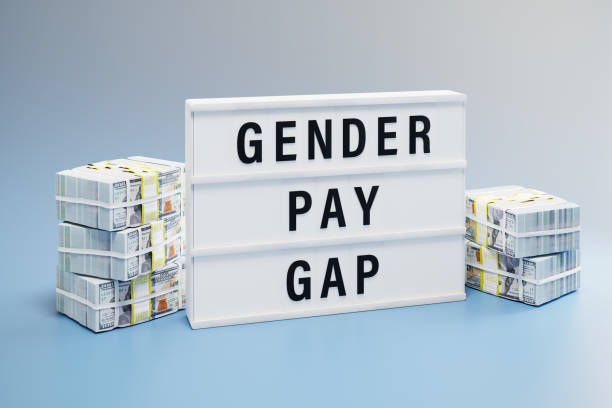
The gender pay gap has existed as women exercised their right to work in various fields. The truth is, the validity of this topic has been debated since the beginning. This article doesn’t focus on the gender debate, so please avoid considering it as a gender conflict.
This is more of an open-minded piece to understand the gender pay gap and its current true validity. The history of gender pay gaps is connected to labor history and limitations on women’s opportunities and earnings. So let’s dig in.
What Is the Gender Pay Gap?
The “gender pay gap” refers to the difference in average earnings between men and women. The gender pay gap is measured by comparing full-time men and women’s median or mean wages.
The pay gap is present in many countries due to factors like discrimination, occupational segregation, and caregiving responsibilities.
Legal protections and affirmative action policies in some countries aim to address the gender pay gap, yet progress is slow. Women’s underrepresentation in higher-paying industries and positions, along with barriers to advancement and workplace discrimination, persists.
Unfortunately. The gender pay gap varies by race and ethnicity, with some groups facing greater disparities, like “discrimination in discrimination.” For example, in the United States, the pay gap is larger for black and Hispanic women compared to white women.
Closing the gender pay gap promotes equity, and justice, and boosts the economy by empowering women’s income and spending. Closing the pay gap involves policies for equal pay, supporting women in the workforce, and addressing workplace bias.
History Of the Gender Pay Gap
Women have been exercising their right to work and making progress in the workplace for over a century. However, despite all of this time and the initial breakthrough, they did not push for pay equality in the workplace. It advocated for women to be overworked both at home and at work while still being underpaid.
History of the pay gap in America
Dating back to the country’s founding, the United States has faced a longstanding issue with the gender pay gap. Women in the early 20th century faced unequal pay for the same work and limited job opportunities.
The Equal Pay Act of 1963 was a significant step in addressing the gender pay gap in the US. The Act mandates equal pay for substantially similar work and demands employers provide legitimate justifications for pay differences.
Despite the Equal Pay Act, the pay gap in the United States has remained persistent. The pay gap narrowed slightly after the Act’s passage, but it has mostly stagnated for decades. According to data from the U.S. Census Bureau, in 2019, women working full-time in the United States earned 82 cents for every dollar earned by men.
In the United States, the pay gap varies by race and ethnicity, with some groups facing larger disparities. In 2019, black women in the US earned 61 cents and Hispanic women earned 53 cents compared to white men.
Efforts to address the gender pay gap in the United States have included legislation such as the “Lilly Ledbetter Fair Pay Act of 2009,” which extended the time frame in which employees can file pay discrimination claims, and the “Paycheck Fairness Act,” which has been introduced in Congress multiple times but has not yet been passed.
History of the pay gap in Africa
The gender pay gap in Africa is attributed to factors like discrimination, cultural beliefs, occupational segregation, and caregiving responsibilities.
In some countries in Africa, legal protections and affirmative action policies have been implemented to address the gender pay gap, but progress in “closing the gap has been slow.” Phumzile Mlambo-Ngcuka, the executive director of UN Women, told Africa Renewal in an interview. Women frequently encounter barriers to advancement, discrimination, and underrepresentation in higher-paying industries and positions.
Innovative Tech Solutions, Tailored for You
Our leading tech firm crafts custom software, web & mobile apps, designed with your unique needs in mind. Elevate your business with cutting-edge solutions no one else can offer.
Start NowWhile Africa has one of the highest numbers of women parliamentarians in the world in 2015 (Rwanda has 64%), many countries on the continent also have the lowest number of women in parliament. Women parliamentarians in the Comoros, Congo, Egypt, Gambia, and Nigeria, for example, still make up less than 9% of their countries’ parliamentarians, according to the report. By August 2015, women held 23% of parliamentary seats in sub-Saharan Africa, up from 3% in 1990.
The gender pay gap in Africa also varies by country, with some countries experiencing larger pay gaps than others. In 2019, South Africa had a gender pay gap of 26.7%, and Ghana’s gap was 22.6%, based on ILO data.
Efforts in Africa to address the gender pay gap include equal pay initiatives, supporting women in the workforce, and combating workplace discrimination.
History of the pay gap in Europe
The gender pay gap has been a longstanding issue in many countries in Europe. In some countries in Europe, legal protections and affirmative action policies have been implemented to address the gender pay gap, but progress in closing the gap has been slow. Women’s underrepresentation in higher-paying industries and positions, along with barriers to advancement and workplace discrimination, persists.
The gender pay gap in Europe also varies by country, with some countries experiencing larger pay gaps than others. In 2019, data from the European Union showed a 21.5% gender pay gap in Germany and 15.8% in Luxembourg.
Some countries have, in a bid to change things, implemented affirmative action policies to increase the representation of women in leadership roles and in higher-paying industries.
Closing the gender pay gap in Europe is important because it can lead to more equitable and just societies, and it can also have a positive impact on the economy by increasing the overall income and spending power of women.
The effects of the pay gap
If, after a few days of searching, you see there is no positive effect of the pay gap, that should ultimately say a lot. If an action has no positive impact on the parties involved, can it truly be considered a “good effect”?
The gender pay gap can have significant effects on individuals and society as a whole. Some effects include:
- Economic inequality: The gender pay gap contributes to economic inequality between men and women, as it can result in women having less disposable income and less financial stability. This can lead to women being more vulnerable to poverty, especially in the event of a financial crisis or job loss.
- Retirement insecurity: The gender pay gap can also have an impact on women’s retirement security, as they are more likely to have lower retirement savings due to earning less over the course of their careers. This can lead to women being more reliant on social security and other forms of support in retirement.
- Career advancement: The gender pay gap can also affect women’s career advancement and opportunities, as women may be less likely to be promoted or given leadership roles if they are paid less than their male counterparts. This can lead to a further perpetuation of the gender pay gap over time.
- Work-life balance: The gender pay gap can also have an impact on women’s ability to achieve a healthy work-life balance, as women may be more likely to take on caregiving responsibilities or work part-time in order to manage these responsibilities. This can lead to a trade-off between work and family life and have negative effects on women’s overall well-being.
The gender pay gap has a compounding effect that results in a woman’s reduced earning capacity over her lifetime.
What has been done to fix the pay gap?
Some countries have diligently addressed the gender pay gap, ensuring equal pay and favorable work conditions. Germany and Sweden have been rumored to be doing such a great job in closing the gap.
However, here are some of the steps taken in some countries to close the pay gap
Remedy in the U.S
In the United States, several actions have been taken to try to shrink the gender pay gap. These include:
- The Equal Pay Act of 1963: This legislation prohibits employers from paying unequal wages to men and women who perform substantially similar work and requires that employers justify any differences in pay with legitimate, non-discriminatory factors.
- The Lilly Ledbetter Fair Pay Act of 2009: The legislation extended the time frame for employees to file pay discrimination claims, empowering women to challenge workplace inequities.
- The Paycheck Fairness Act: This legislation, which has been introduced in Congress multiple times but has not yet been passed, would strengthen the Equal Pay Act and provide additional protections against pay discrimination, including prohibiting employers from retaliating against employees who discuss their wages and requiring employers to demonstrate that any pay differences are based on legitimate factors.
- Executive orders and regulations: Some presidents have issued executive orders or implemented regulations aimed at addressing the gender pay gap, including President Obama’s 2014 executive order requiring federal contractors to provide data on employee compensation.
- State and local laws: Some states and cities have implemented their own laws and policies aimed at addressing the gender pay gap, including measures to promote pay transparency and prohibit wage discrimination.
Remedy in some African countries
In many countries in Africa, a variety of actions have been taken to try to shrink the gender pay gap. These include:
- Legal protections: Countries like Rwanda have implemented laws and policies aimed at addressing the gender pay gap, including equal pay for equal work provisions and protections against wage discrimination. This is why they rank lowest in Africa when it comes to the pay gap.
- Affirmative action: Countries like Rwanda, Namibia, South Africa, and Senegal have implemented affirmative action policies to increase the representation of women in leadership roles and in higher-paying industries.
- Support for women in the workforce: Countries in Africa Like Senegal and Rwanda, these countries have implemented initiatives to support women in the workforce, including training and education programs, mentorship opportunities, and initiatives to promote work-life balance.
- Advocacy and awareness-raising: Some organizations in Africa have worked to raise awareness about the gender pay gap and advocate for policies and initiatives to address it.
- Research and data collection: Some organizations in Africa have conducted research on the gender pay gap and collected data on the issue in order to better understand the causes and consequences of the pay gap and inform efforts to address it.
Overall, efforts to shrink the gender pay gap in Africa have often focused on promoting equal pay for equal work, increasing the representation of women in leadership and higher-paying positions, and supporting women in the workforce. This, however, easily begs the question “has any of these worked?”
Does the gender pay gap still exist?
I mean, if you are still asking this question, you definitely have not been following. In Africa, only about five countries actively address a problem affecting almost all, reflecting low value for workers.
In the U.S., women earn 83 cents for every dollar earned by men, highlighting gender-based wage disparities. Women of color are paid 53–65 cents to every 83 cents that white women are paid. The imbalance is still there and, unfortunately, is not taken seriously enough.
However, I would admit that the reiterating of this has brought “awareness.” Awareness has increased, making people more vigilant compared to two decades ago when discrimination went unpunished. Now, the laws and the presence of social media have made people more aware and assertive. This was evident in the case of Catt Sandler, who quit her job at E! after finding out her male co-host earned twice of what she earned. a co-host who did the exact same job as she did.
The gender pay gap can go unnoticed in societies that lack awareness or disbelief about its existence. It’s your business too, as we live in a “domino effect” world where everything is interconnected. This is our fight.
Before You Go…
Hey, thank you for reading this blog to the end. I hope it was helpful. Let me tell you a little bit about Nicholas Idoko Technologies. We help businesses and companies build an online presence by developing web, mobile, desktop, and blockchain applications.
We also help aspiring software developers and programmers learn the skills they need to have a successful career. Take your first step to becoming a programming boss by joining our Learn To Code academy today!
Be sure to contact us if you need more information or have any questions! We are readily available.











